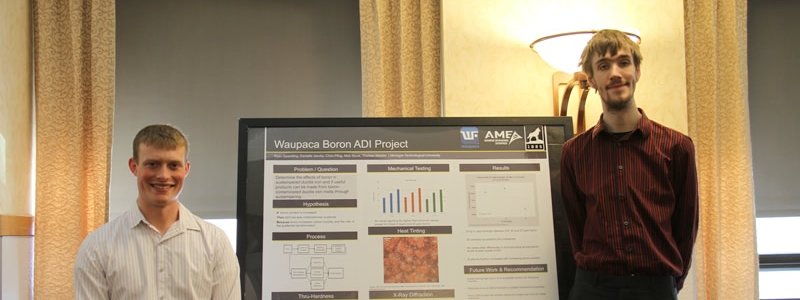3-D Printed Expendable Pattern—Advanced Printed Materials
Team Members
Alex Ball, Kristen Bull, Simon Eddy, and Lewis Marshall, Materials Science and Engineering
Advisors
Paul Sanders and Russell Stein, Materials Science and Engineering
Sponsor
Mercury Marine—Mercury Casting
Project Overview
Although very well-suited for medium and high-volume production, the lost foam casting
process doesn’t currently allow for prototype or low volume casting due to the need
for a foam pattern tool. An opportunity exists to identify and evaluate 3-D printing
materials suitable for use in the lost foam casting process. This could include development
of new materials as well as evaluation of existing, commercially available materials.
We are working in conjunction with the Mercury Marine—Mercury Castings Rapid Prototype
Expendable Pattern—Phase II project team, who will be continuing the investigation
on printing techniques and casting geometries.
Pultrusion Die Failure Analysis
Team Members
Emily Marciniak, Adam DeYoung, Ryan Hebner, and Tyler Kiszelik, Materials Science
and Engineering
Advisor
Russell Stein, Materials Science and Engineering
Sponsor
Easton Technical Products
Project Overview
Easton Technical Products is the leading American manufacturer of carbon fiber arrows.
Carbon fiber arrows are manufactured using a chrome-plated steel die. The dies have
been experiencing variation in service life due to the chrome separating from the
steel. Once the chrome is separated from the steel, the die can no longer be used
resulting in lost production time and increased operating costs. Our team was tasked
with identifying the root cause of the chrome failure, identifying ways new dies can
be checked for quality, and proposing a solution to prevent future chrome plating
failures.
Effects of Boron in Austempered Ductile Iron
Team Members
Ryan Spaulding, Danielle Jencks, Chris Pflug, Nick Stuve, and Thomas Weston, Materials
Science and Engineering
Advisor
Joe Licavoli, Materials Science and Engineering
Sponsor
Waupaca Foundry
Project Overview
Boron is a trace element used in some steels to increase hardenability and accelerate
the transformation rate of austenite to martensite. Significant amounts of high-boron
steel make it into the scrap stream of a foundry, resulting in issues in the manufacturing
of ductile iron. The goal of this project is to determine the effects of boron in
varying concentrations and casting section thicknesses. The austempering process is
being investigated as a possible option for mitigating the negative effects of boron
contamination.
Stainless Steel Boiler Tube Failure Analysis
Team Members
Morgan Jons, Tristan Kolb, Curtis McKenney, and Bailey Rudolph, Materials Science
and Engineering
Advisor
Walt Milligan, Materials Science and Engineering
Sponsor
DTE Energy
Project Overview
DTE Energy uses 347H stainless steel tubing within the boilers of their coal-fired
power plants. Our team is investigating premature intergranular failures of the tubing
by transverse cracking at the toe of weld attachments. Characterizing these failures
and determining root causes or possible solutions can be of help to the industry.
Through failure analysis and material characterization, our team will make recommendations
for long term and short term tube replacement.
Design and Production of Lightweight, High Temperature Aluminum Brake Rotors
Team Members
Philip Staublin, Josh Dorn, Aaron Cook, and Mark Ilenich, Materials Science and Engineering
Advisor
Tom Wood, Materials Science and Engineering
Sponsor
Ford Motor Company
Project Overview
Aluminum brake rotors promise significant weight savings on automotive vehicles fleetwide,
delivering a significant increase in fuel economy and automotive performance. Developmental
aluminum rotors have passed every test at Ford Motor Company, except the extreme “Auto
Motor and Sport” test, which subjects the rotors to temperatures above 500 degrees
Celsius. Our team’s goal is to evaluate existing aluminum alloys and develop a new,
castable, lightweight aluminum alloy capable of providing the required performance
at such high temperatures. Our team has introduced thermally-stable intermetallic
phases with high volume fractions that enable the alloy to provide modest strength
for short times at extreme temperatures.
